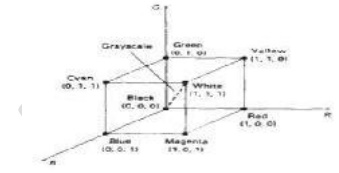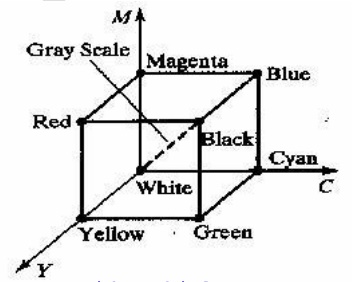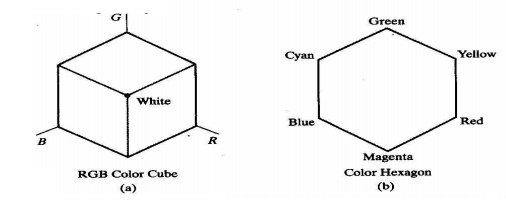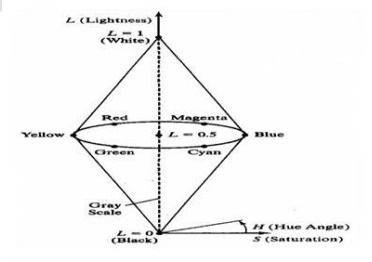Chapter: Computer Graphics and Multimedia
Color Models
Color Models
Color
Model is a method for explaining the properties or behavior of color within some
particular context. No single color model can explain all aspects of color, so
we make use of different models to help describe the different perceived
characteristics of color.
Properties of Light
Light is
a narrow frequency band within the electromagnetic system.
Other
frequency bands within this spectrum are called radio waves, micro waves,
infrared waves and x-rays. The below fig shows the frequency ranges for some of
the electromagnetic bands.

Each
frequency value within the visible band corresponds to a distinct color.
At the
low frequency end is a red color (4.3*104 Hz) and the highest
frequency is a violet color (7.5 *10 14Hz)
Spectral
colors range from the reds through orange and yellow at the low frequency end
to greens, blues and violet at the high end.
Since
light is an electro magnetic wave, the various colors are described in terms of
either the frequency for the wave length λ of the wave.
The wave
length ad frequency of the monochromatic wave are inversely proportional to
each other, with the proportionality constants as the speed of light
C where C
= λ f
A light
source such as the sun or a light bulb emits all frequencies within the visible
range to produce white light. When white light is incident upon an object, some
frequencies are reflected and some are absorbed by the object. The combination
of frequencies present in the reflected light determines what we perceive as
the color of the object.
If low
frequencies are predominant in the reflected light, the object is described as
red. In this case, the perceived light has the dominant frequency at the red
end of the spectrum. The dominant frequency is also called the hue, or simply
the color of the light.
Brightness
is another property, which in the perceived intensity of the light.
Intensity
in the radiant energy emitted per limit time, per unit solid angle, and per
unit projected area of the source.
Radiant
energy is related to the luminance of the source.
The next
property in the purity or saturation of the light.
o Purity describes how washed out or how pure
the color of the light appears.
o Pastels and Pale colors are described as less
pure.
The term
chromaticity is used to refer collectively to the two properties, purity and
dominant frequency.
Two different
color light sources with suitably chosen intensities can be used to produce a
range of other colors.
If the 2
color sources combine to produce white light, they are called complementary
colors. E.g., Red and Cyan, green and magenta, and blue and yellow.
Color
models that are used to describe combinations of light in terms of dominant
frequency use 3 colors to obtain a wide range of colors, called the color
gamut.
The 2 or
3 colors used to produce other colors in a color model are called primary colors.
Standard Primaries
XYZ Color
The set
of primaries is generally referred to as the XYZ or (X,Y,Z) color model
where X,Y
and Z represent vectors in a 3D, additive color space.
Any color
Cλ is expressed as
|
Cλ = XX + YY + ZZ------------- |
(1) |
Where X,Y
and Z designates the amounts of the standard primaries needed
to match
Cλ.
It is
convenient to normalize the amount in equation (1) against luminance (X+ Y+ Z).
Normalized amounts are calculated as,
x = X/(X+Y+Z), y
= Y/(X+Y+Z), z = Z/(X+Y+Z)
with x +
y + z = 1
Any color
can be represented with just the x and y amounts. The parameters x and y are
called the chromaticity values because they depend only on hue and purity.
If we
specify colors only with x and y, we cannot obtain the amounts X, Y and Z. so,
a complete description of a color in given with the 3 values x, y and Y.
X = (x/y)Y, Z
= (z/y)Y
Where z =
1-x-y.
Intuitive Color Concepts
Color
paintings can be created by mixing color pigments with white and black pigments
to form the various shades, tints and tones.
Starting
with the pigment for a „pure color‟ the color is added to black pigment to
produce different shades. The more black pigment produces darker shades.
Different
tints of the color are obtained by adding a white pigment to the original
color, making it lighter as more white is added.
Tones of
the color are produced by adding both black and white pigments.
RGB Color Model
Based on
the tristimulus theory of version, our eyes perceive color through the
stimulation of three visual pigments in the cones on the retina.
These
visual pigments have a peak sensitivity at wavelengths of about 630 nm (red),
530 nm (green) and 450 nm (blue).
By
comparing intensities in a light source, we perceive the color of the light.
This is the
basis for displaying color output on a video monitor using the 3 color
primaries, red, green, and blue referred to as the RGB color model. It is
represented in the below figure

Vertices
of the cube on the axes represent the primary colors, the remaining vertices
represents the complementary color for each of the primary colors.
The RGB
color scheme is an additive model. (i.e.,) Intensities of the primary colors
are added to produce other colors.
Each
color point within the bounds of the cube can be represented as the triple
(R,G,B) where values for R, G and B are assigned in the range from 0 to1.
The color
Cλ is expressed in RGB component as
Cλ = RR + GG + BB
The
magenta vertex is obtained by adding red and blue to produce the triple (1,0,1)
and white at (1,1,1) in the sum of the red, green and blue vertices.
Shades of
gray are represented along the main diagonal of the cube from the origin
(black) to the white vertex.
YIQ Color Model
The
National Television System Committee (NTSC) color model for forming the
composite video signal in the YIQ model.
In the
YIQ color model, luminance (brightness) information in contained in the Y
parameter, chromaticity information (hue and purity) is contained into the I
and Q parameters.
A combination
of red, green and blue intensities are chosen for the Y parameter to yield the
standard luminosity curve.
Since Y
contains the luminance information, black and white TV monitors use only the Y
signal.
Parameter
I contain orange-cyan hue information that provides the flash-tone shading and
occupies a bandwidth of 1.5 MHz.
Parameter
Q carries green-magenta hue information in a bandwidth of about 0.6MHz.
CMY Color Model
A color
model defined with the primary colors cyan, magenta, and yellow (CMY) in useful
for describing color output to hard copy devices.
It is a
subtractive color model (i.e.,) cyan can be formed by adding green and blue
light. When white light is reflected from cyan-colored ink, the reflected light
must have no red component. i.e., red light is absorbed or subtracted by the
link.
Magenta
ink subtracts the green component from incident light and yellow subtracts the
blue component.

In CMY
model, point (1,1,1) represents black because all components of the incident
light are subtracted.
The
origin represents white light.
Equal
amounts of each of the primary colors produce grays along the main diagonal of
the cube.
A
combination of cyan and magenta ink produces blue light because the red and
green components of the incident light are absorbed.
The
printing process often used with the CMY model generates a color point with a
collection of 4 ink dots; one dot is used for each of the primary colors (cyan,
magenta and yellow) and one dot in black.
The
conversion from an RGB representation to a CMY representation is expressed as
[ ] [ ] [ ]
Where the
white is represented in the RGB system as the unit column vector.
Similarly the conversion of CMY to RGB
representation is expressed as [ ] [ ] [ ]
Where
black is represented in the CMY system as the unit column vector.
HSV Color Model
The HSV
model uses color descriptions that have a more interactive appeal to a user.
Color
parameters in this model are hue (H), saturation (S), and value (V). The 3D
representation of the HSV model is derived from the RGB cube. The outline of
the cube has the hexagon shape.

The boundary of the hexagon represents the various hues, and it is used
as the top of the HSV hexcone.
In the
hexcone, saturation is measured along a horizontal axis, and value is along a
vertical axis through the center of the hexcone.
Hue is
represented as an angle about the vertical axis, ranging from 00 at
red through 3600. Vertices of the hexagon are separated by 600
intervals. Yellow is at 600, green at 1200 and cyan
opposite red at H = 1800. Complementary colors are 1800
apart.
Saturation S varies from 0 to 1. the maximum purity at S = 1, at S =
0.25, the hue is said to be one quarter pure, at S = 0, we have the gray scale.
Value V
varies from 0 at the apex to 1 at the top.
the apex
representation black.
At the
top of the hexcone, colors have their maximum intensity.
When V =
1 and S = 1 we have the „pure‟ hues.
White is
the point at V = 1 and S = 0.
HLS Color Model
HLS model
is based on intuitive color parameters used by Tektronix.
It has
the double cone representation shown in the below figure. The 3 parameters in
this model are called Hue (H), lightness (L) and saturation (s).
Hue
specifies an angle about the vertical axis that locates a chosen hue.

In this
model H = θ0 corresponds to Blue.
The
remaining colors are specified around the perimeter of the cone in the same
order as in the HSV model.
Magenta
is at 600, Red in at 1200, and cyan in at H = 1800.
The
vertical axis is called lightness (L). At L = 0, we have black, and white is
at L
= 1 Gray
scale in along the L axis and the “purehues” on the L = 0.5 plane.
Saturation
parameter S specifies relative purity of a color. S varies from 0 to 1 pure
hues are those for which S = 1 and L = 0.
As S
decreases, the hues are said to be less pure.
At S= 0,
it is said to be gray scale.
Related Topics